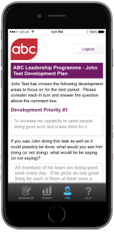So you and your rater network have carried out the 360-degree feedback questionnaire, analysed the report and gathered feedback from your coach… now what?
There are four key groups involved in the 360 feedback process and acting on each of these feedback areas is crucial to growing, developing and learning. In this blog, we’ll explore the 7th stage of the 360-degree feedback process, known as ‘checking out’.
The 360 feedback report itself is usually not definitive enough to produce clear development actions - in our experience it always raises more questions than answers. For this reason, we encourage the participant to go away from this first ‘Explore Your click-360 Report’ session with an outline plan of at least one Strength (S) and up to 3 Development Priorities (DPs) and with a commitment to undertake further exploration around the DPs, using the Checking-Out process.
What Is The Checking Out Process?
Following the 360 feedback report is the checking out process, this is to resolve any ambiguity and conflict as well as to pick up learnings and suggestions.
Checking-out is about gaining further depth and clarity via verbal feedback from a representative proportion of the rater network – the people who contributed anonymously.
This is also an opportunity to investigate any areas that don’t make sense, are unclear, confusing, or any areas of conflict (where different raters appear to think the opposite of each other).
Who Is Involved In The Checking Out Process?
At click360SelfDrive we aim to inspire, motivate and guide the participant to carry out this process on their own. We coach the individuals on how to do this by first selecting the relevant development priorities from the report that they wish to check out with each respective rater category. The ‘must haves’ are the manager, and the direct reports. When it comes to the other categories, a representative sample is sufficient.
Each development priority should be described in as short a sentence as possible. For example “To make more effort to ask each team member for their input”, “To catch people doing things right” or “To improve my monthly report”. The goal is to get greater depth and clarity around each DP by asking the Golden Question.
Golden Question: "If I was performing at my peak in this respect, what would I be doing/not doing, saying/not saying?" or “If I was the best I could be at this, what would it look like (what would I be doing/not doing, saying/not saying)?”
Online Checking Out
Making the most of your 360 feedback is critical and at click360SelfDrive we understand that it isn't always possible to chase up the raters or have verbal conversations.
Rather than booking in meetings and reminders our 360 feedback software automatically generates an email to each rater asking them the Golden Question around each DP. As well, they are asked to offer learning suggestions in an effort to enhance the quality of the development plan.
Rater contributions are captured anonymously in a separate section of the interactive report which triggers an email to the participant, allowing the participant to see a notification which reads “You Have New Feedback”.
As this is an optional step – raters can choose not to respond – it is possible that not everyone will take up their invite, however because the function is easily completed on any hand-held mobile device it is likely that many will, leading to an improvement in the quality of the participant’s plans.
Moreover, this part of the process increases the buy-in of colleagues and promotes a culture where feedback is freely given and received.

How To Act On Your 360 Feedback
Why?
- Deepening the participant’s understanding
- Building a more robust personal development plan
- Checking out any areas of ambiguity/conflict
- Strengthen relationships with all rater categories, increasing trust and authenticity
How?
- Arrange a one-to-one session or a group session if applicable
- Thank them for participating in the process
- Share your feedback – the highlights of strengths and development priorities
- Ask the Golden Question for each DP
- Stay open: listen and don’t defend
- Stay open: ask for further clarification if not clear
- Ask if they have any development suggestions
The ultimate goal of the checking out process is to update the development action plan with the new information gathered.
At click360SelfDrive, we support a range of organisations in their 360 feedback processes. One of our recent projects is with the RAF who are now entering the 360 checking-out phase. It’s early days, but they’re making great progress so far.
If your organisation is interested in the 360 feedback process, checking out, or just general feedback support, please don’t hesitate to get in touch.